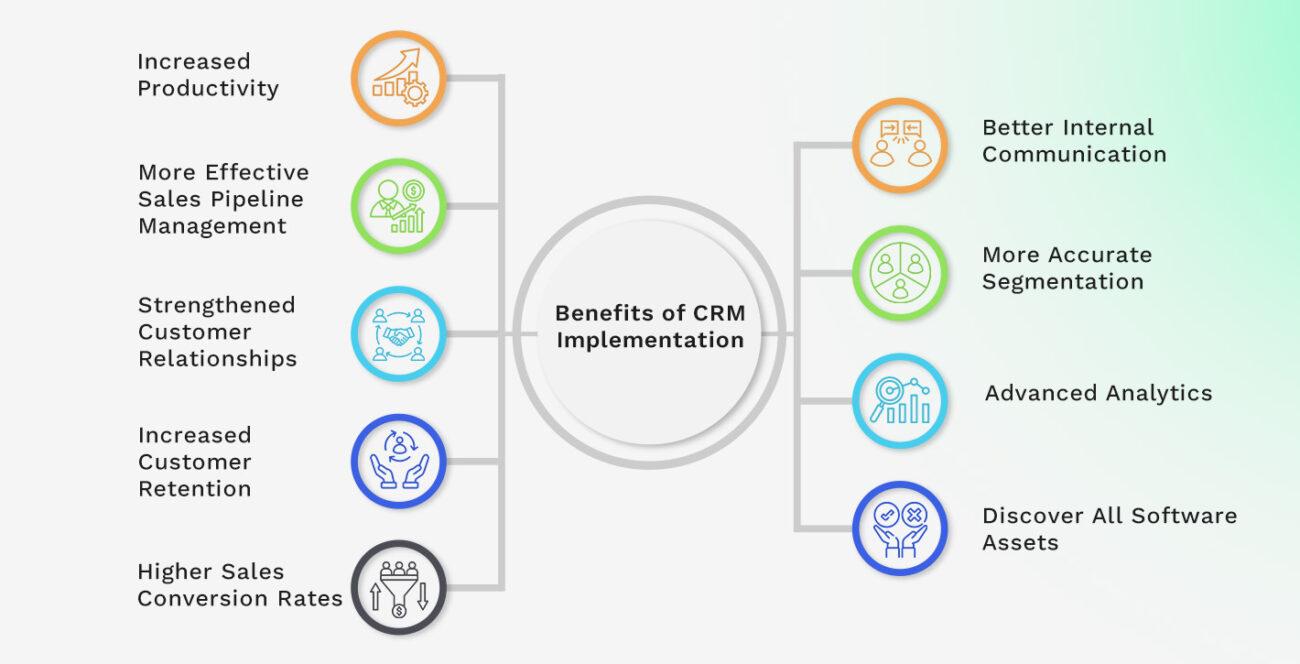Did you know that 74% of companies with strong CRM strategies see improved customer relationships? This shows how vital a well-thought-out CRM plan is for your business. A successful CRM rollout helps manage customer relationships better and uses data to make your operations more efficient and grow your business.
Putting a CRM system in place means following 10 key steps. These steps make sure your move is smooth, and you get the most out of your CRM strategy. Choosing the right system and doing these steps well will significantly improve how you connect with customers and help your business succeed.
What Is CRM Implementation?
The definition of CRM implementation is about setting up CRM software that fits your business. It's a detailed process that helps companies manage important customer data. This includes things like contact info, past interactions, and what they buy.
This info is put into customer management systems. It helps with making better decisions and planning for the future.
Getting CRM implementation right means making the software fit your business needs. This makes it easy for your team to use and get the most out of it. It helps with personal customer interactions.
With a strong CRM system, your business can understand what customers want better. This leads to happier customers, more loyalty, and growth.
Why Is CRM Implementation Important?
CRM implementation makes operations smoother and improves customer interaction. It also makes data more accurate. CRM systems help sales, marketing, and customer service teams work better together, leading to more work done.
CRM systems offer more than just better internal processes. They give you insights into what customers want. This lets you meet their needs before they ask, making customers happier and more loyal. This can help your business grow over time. Companies that use CRM well often stand out in their field.
Customer needs keep changing, and CRM systems are vital to keep up with these changes. They give you the tools to adjust to new trends and what customers like.
Benefits of CRM Implementation
Choosing a strong CRM system brings many advantages. It changes how you talk to customers and manage your team. Knowing these benefits helps you pick a CRM that adds great value. Here are some key advantages of using CRM well.
Increased Productivity
A good CRM automates routine tasks, allowing your team to focus on more important duties. This enables them to work more efficiently and effectively.
More Effective Sales Pipeline Management
CRM gives you better control over your sales pipeline. You can track leads and opportunities well, making sure you don't miss any deals. This helps you turn more prospects into customers.
Strengthened Customer Relationships
CRM is all about improving customer relationships. You get to see what customers like and talk to them in a way that feels personal. This makes customers more loyal to you.
Increased Customer Retention
CRM helps keep customers coming back. It lets you see who might leave and helps you keep them. This way, you can fix problems before they get worse.
Higher Sales Conversion Rates
Using CRM makes processes smoother and gives sales teams the info they need. This helps them close deals faster.
Better Internal Communication
CRM makes talking within your company better. Everyone can share info on one platform, avoiding mix-ups. This teamwork makes your company run smoother.
More Accurate Segmentation
CRM helps you segment your customers better. This means you can target your marketing better. Your messages will hit the mark with your customers.
Advanced Analytics
CRM tools give you deep insights into customer behavior and market trends. This information helps you make smart business choices immediately.
More Informed Decision-Making
In the end, CRM leads to smarter decisions. You get to see everything about customer interactions and sales results. This puts your business on the path to growth and happier customers.

10 Steps to a Successful CRM Implementation
Implementing a CRM system needs a step-by-step plan. This ensures your team works towards the company's goals. Following these steps makes the transition smoother and boosts your CRM strategy.
Form Your CRM Selection and Implementation Teams
Put together teams from sales, marketing, and IT. This mix of skills makes everyone feel part of the project. It leads to a CRM solution that fits everyone's needs.
Define Your CRM Goals, Requirements, and Budget
Know what you want from your CRM system. Set clear goals and a budget that makes sense. This planning is key for a successful CRM setup and keeps your project on track.
Identify Necessary CRM Integrations
Look at your current tools to see what integrations you need. Figuring this out early stops future problems with your CRM.
Assess CRM Solution Options
Do your homework on CRM options. Look at their features, ease of use, and support in order to make a wise choice that ensures successful customer relationship management.
Choose the Best CRM for Your Needs
After looking at options, pick the CRM that fits your goals, budget, and needs. This choice is key for your team to manage customer relationships well.
Prepare Data for CRM Migration
Get your data ready for the CRM switch. Clean and update your data to make sure it's accurate. This step saves time and effort later on.
Test the New CRM System
Test the CRM system before using it fully. Check how easy it is to use, how well it integrates, and if it generates reports right. Testing helps fix problems before the full launch.
Develop a Final Training and Support Plan
Plan detailed training for your team. Good training helps users get the most out of the CRM, supporting your CRM strategy.
Implement the CRM System
Roll out the CRM across your company. Keep an eye on the process and help your team as needed.
Track Performance and Make Adjustments as Needed
Check how the CRM is doing after it's been used. Look for ways to improve and make changes. Being flexible with your CRM ensures you get the most from it.

What Does a CRM Implementation Cost?
Understanding the CRM implementation costs is key to good financial planning. The cost can change based on the platform, the number of users, and the features you need. On average, costs range from $8 to $1,250 per user each month. This covers everything from basic to advanced features.
When budgeting for CRM, remember to add training, support, and possible downtime costs. Failing to include these extra costs in your budget can lead to unexpected expenses later.
Kohezion: A Versatile CRM Solution for Streamlined Customer Relationship Management
Kohezion is a top choice for managing customer relationships. It offers customizable features that make it easy for your team to use. This makes managing customer relationships smoother.
Kohezion helps you gather, analyze, and use important customer data easily. It's flexible, so you can change it to fit your business needs. With Kohezion, your business can build stronger customer ties and work more efficiently.
Kohezion CRM is known for improving user experience and offering solutions that grow with your business. It's a standout in the competitive market.
Conclusion
A successful CRM implementation helps improve customer relationships and sales processes. Following the steps and understanding the benefits, like better productivity and more sales, will help you make the most of your CRM system.
Implementing CRM well makes your business run smoother and builds customer loyalty as it grows. Using these strategies lets you use CRM to its fullest, helping your business grow over time.
As you go forward, focus on CRM implementation to overcome challenges and grab new chances in a tough market. Focusing on these steps will set you up for ongoing success and ensure a great customer experience.
Contact us at Kohezion to discover how our CRM solutions can support your business’s growth and success.
Start building with a free account
Frequently Asked Questions
Involving end-users is important because they are the ones who will use the CRM daily. Their input helps ensure the system meets their needs and is user-friendly. Engaging them early on can also improve adoption rates and reduce resistance to change.
Customization requests should be evaluated carefully to ensure they align with your CRM goals. Prioritize changes that add significant value and are necessary for your business processes. Too many customizations can complicate the system, so focus on those that improve efficiency and user experience.
Common pitfalls include inadequate planning, insufficient user training, and poor data migration. Failing to involve key stakeholders and not addressing user feedback can also lead to issues. Avoiding these pitfalls requires thorough planning, clear communication, and ongoing support throughout the rollout process.
Assess whether the CRM meets planned goals to measure the success of your implementation. Track key performance indicators such as user adoption rates, data accuracy, and sales or customer service improvements. Regularly review these metrics to ensure the CRM delivers the expected benefits and adjust as needed.

